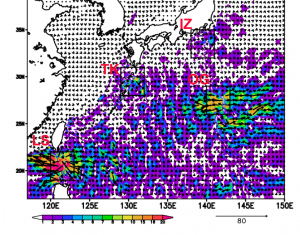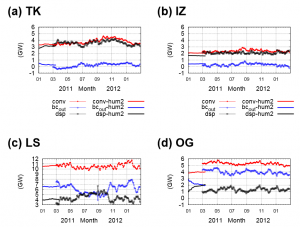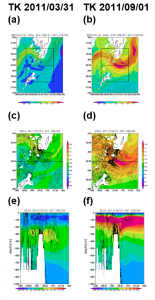by Sergey Varlamov (APL JAMSTEC)
In paper of Varlamov et al. (2015)[1], authors analyzed results of concurrent annual simulation of ocean circulation and tidal currents using a data assimilative ocean general circulation model covering the Western North Pacific with horizontal resolution of 1/36 degree (JCOPE-T) to investigate possible interactions between them. To confirm the reproducibility of tidal processes by given model, model data were compared with the tidal gauge data and, for validation of the surface manifestation of the baroclinic tide, with the space high-pass filtered satellite SSHA data. The intense variability of the M2 baroclinic tide harmonics around Tokara Strait, Izu Ridge, Luzon Strait, and Ogasawara Ridge (the hot spots, Fig. 1) are represented by the model nearly as observed.

Special experiment with M2 only tidal forcing was used for analyzing variability of M2 internal tides with the primary attention to the barotropic to baroclinic energy conversion rate (BEC). Special forcing allows the calculation of M2 harmonics for a short-term (3-day) period. Energy cycle analysis of the simulated M2 baroclinic tide indicates two types of the hot spots: dissipation (Tokara Strait and Izu Ridge) and radiation (Luzon Strait and Ogasawara Ridge) dominant sites (Fig. 2). BEC mainly occurs over the bottom slope at the relatively shallow depth at Tokara Strait and Izu Ridge, and thus most of the baroclinic tidal energy is locally dissipated and the stratification in the relatively shallow layer is crucial for the modulation of the baroclinic tide generation. At the other two spots, in contrast, the radiation of the baroclinic tidal energy is more active than at the former spots because of the relatively deep bottom slope where the active energy conversion occurs, and the stratification in the relatively deep layer is influential in the modulation of the baroclinic tide generation.

Energy conversion from barotropic to baroclinic M2 tides at the hot spots is modulated considerably by the lower-frequency changes in the density field. The EOF analysis of the buoyancy frequency averaged at the spots indicates that the temporal variations of some EOF modes correlate with the variation of BEC averaged there. Characteristics of the most influential mode at each spot imply the lower-frequency oceanic phenomena that are mainly responsible for modulating the baroclinic tide variability there through changes in intensity of the local stratification. At Tokara Strait (Fig. 3) and Izu Ridge, the enhanced stratification in the upper thermocline layer caused by the development of the Kuroshio small meander together with the seasonal thermocline variation considerably affects the temporal variation of BEC . At Luzon Strait and Ogasawara Ridge, the energy conversion is modulated by the variations in the stratification around the bottom of the main thermocline governed by the Kuroshio intrusion into the South China Sea (Luzon Strait) and the mesoscale eddy activity (Ogasawara Ridge). The remote effect due to the temporal variation of the depth-integrated tidal energy supply, which is caused by BEC occurring over the all baroclinic tide generation sites, is not negligible especially at Luzon Strait, as suggested also by the previous studies [Kerry et al., 2013; 2014].
The multiple regression using the stratification intensity and depth-integrated tidal energy supply does not completely explain the variance of the found energy conversion; in particular, the explained ratio is relatively low at the radiation dominant hot spots: Luzon Strait and Ogasawara Ridge. Detailed BEC processes could be affected by the additional contribution from the local dissipation and advection [Jan et al., 2012]. Future studies await further exploration in these directions.

[Note] This article is the reprint of that in Kuroshio-Oyashio Watch 2015/05/25. Application Laboratory freely distributes the reanalysis data based on JCOPE-T (the JCOPE-T-NEDO reanalysis; with 1/36 horizontal resolution and hourly time resolution from 2002 to present) to any interested persons. The contact for this data is the same as the FRA-JCOPE2 reanalysis.
- [1]Varlamov, S.M., X. Guo, T. Miyama, K. Ichikawa, T. Waseda and Y. Miyazawa, “M2 baroclinic tide variability modulated by the ocean circulation south of Japan”, Journal of Geophysical Research: Oceans (2015), doi: 10.1002/2015JC010739 ↩
